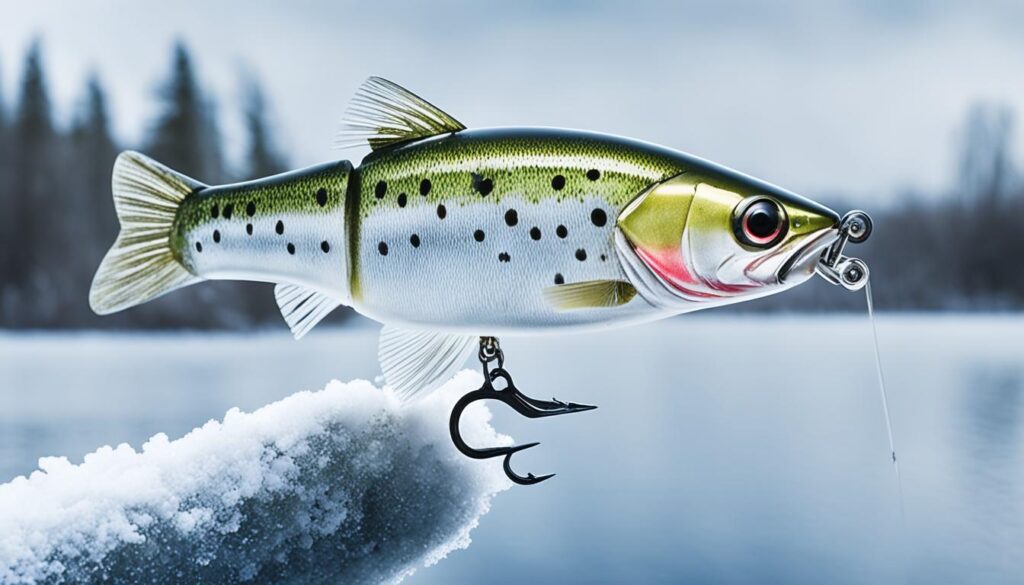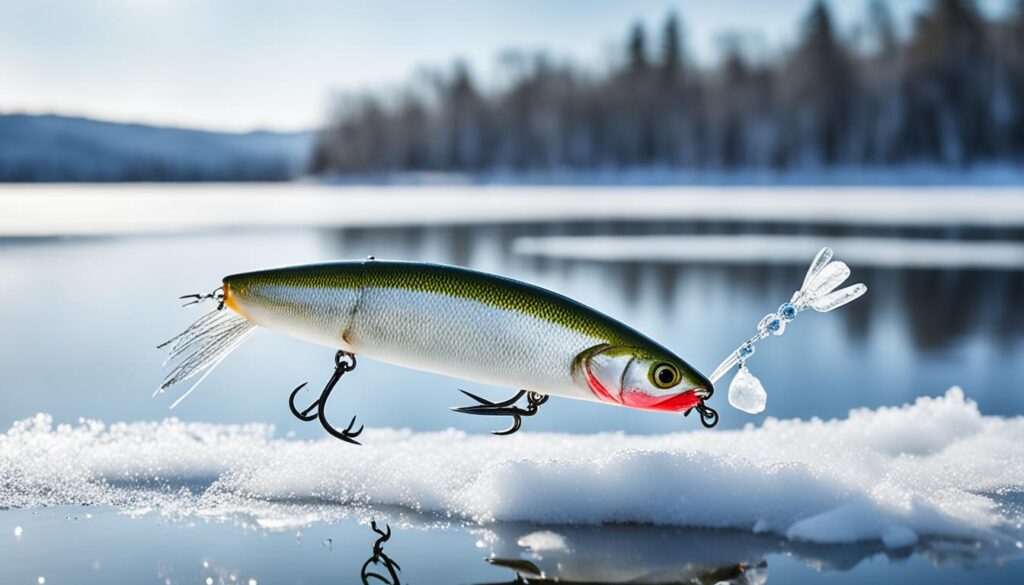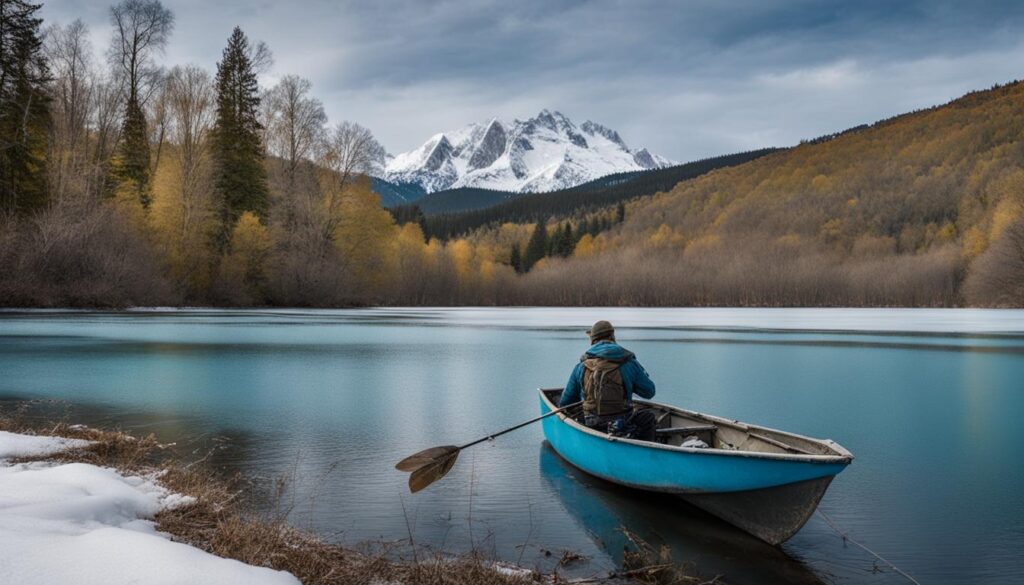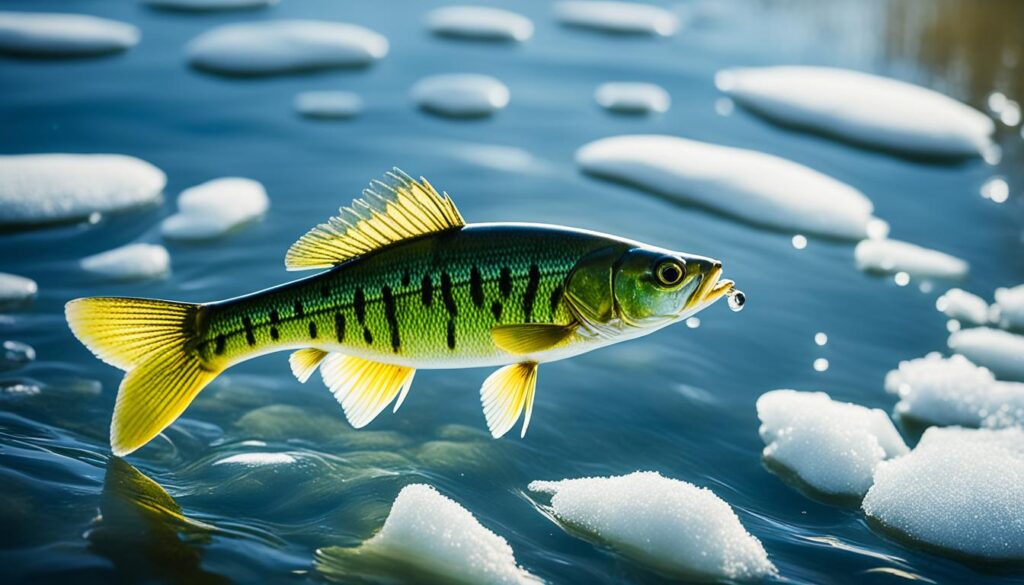In the late winter months, when the water is cold and the air is frigid, many anglers overlook the effectiveness of small jerk baits for catching bass. However, experienced angler Mike Iaconelli advises against this. He recommends utilizing small jerkbaits during this time as they can effectively attract bass. Iaconelli carries a collection of jerkbaits with subtle differences to account for different conditions.
Key Takeaways:
- Small jerkbaits can be highly effective for catching bass in late winter, despite the cold water and sluggish behavior of the fish.
- Jerkbaits that imitate injured baitfish can trigger a response from inactive bass.
- The smaller profile of small jerkbaits is more enticing to lethargic bass that may be less willing to chase larger lures.
- Modifying jerkbaits with different hooks and line choices can enhance their performance and attract more strikes.
- A slower gear ratio reel and a soft rod with a parabolic bend are recommended for optimal results.
Why Small Jerkbaits are Effective in Late Winter
Small jerkbaits are highly effective in late winter for several reasons. First, they imitate the movement of injured baitfish, which can trigger a response from inactive bass. The jerkbait’s lifelike action mimics injured prey’s erratic and wounded swimming pattern, making it irresistible to hungry bass.
Secondly, the smaller profile of the jerkbait can be more enticing to lethargic bass that may be less willing to chase larger, more aggressive lures. In the cold water temperatures of late winter, bass are less inclined to expend energy on chasing down large prey. By presenting a smaller offering, anglers can increase their chances of enticing a strike.
Additionally, the suspending nature of jerkbaits allows for a precise presentation and extended time in the strike zone. When the bass is sluggish and less willing to move, a suspending jerkbait maintains its position, whether it be at a specific depth or suspended in the water column. This allows anglers to work the bait effectively and keep it in front of the fish longer, increasing the likelihood of a strike.
Overall, small jerkbaits are valuable for anglers targeting bass in late winter. Their ability to imitate injured prey, smaller size, and suspending action make them a go-to lure for enticing strikes from lethargic and inactive bass. Anglers who include small jerkbaits in their late winter arsenal will likely see increased success and more fish in the boat.
“Using small jerkbaits in late winter can be a game-changer for anglers. The realistic action and smaller profile imitate injured baitfish, triggering strikes from inactive bass. The suspension of jerkbaits allows for precise presentations and extended time in the strike zone.”
Choosing the Right Small Jerkbait
Choosing the right small jerkbait is crucial for successful late winter bass fishing. With an overwhelming variety of options available, it’s essential to consider a few key factors to maximize your chances of success.
Size Matters
When selecting a small jerkbait, opt for a size around 3 to 4 inches. The Lucky Craft 100 is popular among anglers for its versatility and ability to imitate small baitfish prevalent during late winter. This size is ideal for enticing bass and triggering strikes.
Color Considerations
The color of your small jerkbait can play a crucial role in attracting bass, especially in varying water conditions. Bright or reflective baits are recommended for water with low visibility to enhance visibility and draw attention to your lure. Examples include table rock shad and chartreuse shad.
On the other hand, if you’re fishing in more transparent water, it’s best to opt for more natural or transparent colors. These colors mimic the appearance of baitfish and provide a more realistic presentation. Ghost Minnow, clown, and Chrome Ayu are popular choices in such scenarios.
Just so you know, the specific color selection may vary depending on factors such as water clarity, light conditions, and the behavior of the bass. Experimenting with different colors and observing the bass’s response is essential to determine the most effective option. Experimentation and observation are crucial when choosing the right small jerkbait for late winter bass fishing. By considering the size and color options that best imitate the local baitfish and adjusting based on environmental factors, you’ll increase your chances of enticing bass and achieving a successful fishing outing.

Modifying Small Jerkbaits for Optimal Performance
Modifying small jerkbaits can significantly improve their performance. A straightforward modification is changing the hooks. A VMC Bladed Hybrid Treble Short 1X Hook can add flash and vibration to the lure, enticing more strikes. Swapping out the factory hooks can also alter the buoyancy of the jerkbait. Using larger and heavier hooks can make the bait sink, while smaller and lighter hooks can make the bait float. Altering the hooks in the front or the back can also change the orientation of the bait, making it go nose up or nose down.
The line choice is also critical for suspending jerkbaits. Fluorocarbon lines, such as Berkley Trilene 100% Fluorocarbon, can help the bait run deeper and sink. In contrast, monofilament lines, such as Berkley Trilene Sensation Professional Grade, can make the bait float higher or slowly rise. Experimenting with different modifications is essential to find the most effective combination for late winter bass fishing.
Key Gear for Small Jerkbait Fishing in Late Winter
The right gear is essential for successful small jerkbait fishing in late winter. Here are some key gear considerations to improve your winter bass fishing experience:
- Rod:
Opt for a 6.5 to 7-foot rod with a medium action and a moderate or fast tip. This rod type allows for a precise presentation and proper hookset, increasing your chances of landing that trophy bass.
- Reel:
Choose a spinning or baitcasting reel with a gear ratio of 6.4 or higher. The right reel will depend on your personal preference and fishing style. Could you make sure to select a reel that offers smooth and reliable performance?
- Line:
Line selection is critical when fishing with small jerkbaits in late winter. Opt for 8 to 10-pound test fluorocarbon or a good copolymer line. These lines offer excellent sensitivity and low visibility, increasing your chances of fooling cautious bass.
- Gear Ratio:
A lower gear ratio in your reel can help maintain a steady cadence and slow the presentation down. This is crucial in cold water conditions when bass are less active. Experiment with different gear ratios to find the best one for you.
Remember, the right gear ensures optimal performance and maximizes the effectiveness of small jerkbaits for late winter bass fishing. Equip yourself with quality rods, reels, and lines to increase your chances of success on the water.
Recommended Gear for Small Jerkbait Fishing in Late Winter
| Category | Recommended Gear |
|---|---|
| Rod | 6.5 to 7-foot rod with medium action and moderate or fast tip |
| Reel | Spinning or baitcasting reel with gear ratio of 6.4 or higher |
| Line | 8 to 10-pound test fluorocarbon or good copolymer line |
| Gear Ratio | Lower gear ratio for a steady cadence and slow presentation |
Fishing Techniques for Small Jerkbait Success
Mastering the art of fishing with small jerkbaits is crucial to achieving success in late winter bass fishing. One key technique is the pause. By pausing the jerkbait, it suspends and mimics an injured baitfish, often triggering a strike from nearby bass.
Varying the cadence of the retrieve, such as twitching the jerkbait with short bursts or longer pauses, can also entice more strikes. It’s crucial to pay attention to the behavior of the bass and adjust the retrieve accordingly. Experimenting with different retrieves, such as jerking, ripping, or twitching the jerkbait, can help determine what triggers the most bites.
Another important strategy is targeting areas with cover, such as submerged vegetation, rocks, or points. These structures provide hiding places for bass and create ambush opportunities. By casting near these areas and working the jerkbait through them, anglers can effectively target active fish, significantly increasing their chances of a successful catch.
Combining these fishing techniques can significantly improve the success rate of small jerkbaits in late winter. Adapting the methods based on the specific conditions, water temperature, and bass behavior is essential. Being attentive and willing to adjust the retrieve, cadence, and location can significantly increase the chances of enticing a strike and catching bass.
Quote from Mike Iaconelli: “The key to successful jerkbait fishing is imparting the right action to the bait. Vary your retrieve and experiment to find what triggers the most bites.”

Comparing Fishing Techniques for Small Jerkbait Success
| Technique | Description |
|---|---|
| Pause and Suspend | Imitate an injured baitfish by pausing the jerkbait and allowing it to suspend in the water. |
| Vary Cadence | Change the retrieve cadence with short bursts or longer pauses to entice more strikes. |
| Experiment with Retrieves | Try different retrieves, such as jerking, ripping, or twitching, to determine what triggers the most bites. |
| Target Cover | Fish near areas with cover, such as submerged vegetation, rocks, or points, to increase the chances of enticing a strike. |
Tips for Fishing Small Jerkbaits in Late Winter
Incorporating these tips can significantly increase success when fishing small jerkbaits in late winter. Firstly, focusing on areas with structure or cover, such as points, submerged vegetation, or rocky areas, is crucial. Bass often seek shelter and ambush opportunities in these areas.
Secondly, paying attention to the water temperature and adjusting the retrieve accordingly can make a difference. Slowing down the retrieve and subtle movements can entice sluggish bass in cold water.
Thirdly, making precise casts and presenting the jerkbait close to cover or along specific structures can increase the chances of enticing a strike.
Lastly, it is vital to be observant and adapt to the behavior of the bass. If one technique or color is not producing results, be willing to switch things up and try different approaches.
The Benefits of Small Jerkbaits in Late Winter Bass Fishing
Utilizing small jerkbaits for late winter bass fishing offers several benefits. Firstly, the small size and realistic action of the jerkbait can be highly appealing to lethargic bass in cold water conditions. The suspending nature of the jerkbait allows for precise presentations and extended time in the strike zone, increasing the chances of provoking a strike.
The versatility of small jerkbaits also allows anglers to experiment with different retrieves and fishing techniques, adapting to the behavior and preferences of the bass. By varying the speed, cadence, and depth of the retrieve, anglers can trigger different responses from bass, increasing the chances of success. Jerkbaits can be twitched, ripped, or jerked to imitate the erratic movements of injured baitfish, enticing even the most reluctant bass.
Furthermore, anglers can modify small jerkbaits with different hooks and adjust the line choice to further enhance the bait’s presentation and effectiveness. By adding hooks with blades or changing the weight distribution, anglers can create additional flash and vibration, triggering a reaction from bass in cold water.
“Small jerkbaits are incredibly versatile and allow me to cover a lot of water quickly,” says Mike Iaconelli, a renowned angler with numerous tournament wins. “Their compact size and lifelike action make them irresistible to bass, especially during late winter when the fish are less active.”
“Small jerkbaits are my go-to lures for late winter bass fishing,” adds Iaconelli. “Their ability to suspend in the water column and mimic injured baitfish is a deadly combination that consistently produces results.”

| Jerkbait Benefits | Explanation |
|---|---|
| A small size attracts lethargic bass | Realistic action imitates injured baitfish |
| Suspending nature allows for precise presentations | Extended time in the strike zone increases chances of provoking a strike |
| Versatility in fishing techniques | Experimentation with speed, cadence, and depth triggers various responses from bass |
| Modifiable with different hooks and line choices | Enhances presentation and effectiveness of the bait |
Where to Find Late Winter Bass
Late winter bass can be found in specific areas that provide favorable conditions for their behavior. One prime location is near structure or cover, such as points, submerged vegetation, or rocks. Bass often seek shelter and ambush opportunities in these areas.
Additionally, focusing on areas where the water temperature is slightly warmer, such as shallow bays or pockets, can increase the chances of locating active bass. Attention to water movement, such as current or wind-driven waves, can also help identify where bass may congregate.
Approaching these areas with stealth and making precise casts increases the chances of enticing a strike. By targeting locations that provide favorable conditions, anglers can maximize their catch rate when using small jerkbaits for late winter bass fishing.
| Location | Description |
|---|---|
| Near structure or cover | Points, submerged vegetation, rocks |
| Warmer water areas | Shallow bays, pockets |
| Water movement | Current, wind-driven waves |
Conclusion
Small jerkbaits are often overlooked in late winter bass fishing but can be a game-changer for anglers. Despite the cold water and the sluggish behavior of the fish, small jerkbaits have proven to be highly effective in enticing strikes. By selecting the proper size color and modifying the bait with different hooks, anglers can enhance the performance of small jerkbaits and increase their chances of success.
Proper gear selection is essential for optimal performance. Choosing the right rod, reel, and the appropriate line ensures a precise presentation and maximizes the bait’s effectiveness. Mastering the proper fishing techniques, such as the pause and varying retrieves, increases the chances of attracting bass in late winter. By incorporating small jerkbaits into their fishing arsenal, anglers can target bass in specific locations and adapt to their behavior, increasing their angling success.
In summary, small jerkbaits are valuable for late winter bass fishing. Their small size and realistic action make them highly enticing to lethargic bass in cold water. By utilizing the right gear, applying effective fishing techniques, and understanding the behavior of the Bass, anglers can unlock new opportunities for catching bass in late winter. So next time you hit the cold water, remember to bring your small jerkbaits and discover their exciting potential.
FAQ
Why are small jerkbaits effective in late winter?
Small jerkbaits are effective in late winter because they imitate injured baitfish and have a smaller profile that can entice lethargic bass. The suspending nature of these lures allows for precise presentations and extended time in the strike zone.
How do I choose the right small jerkbait?
When choosing a small jerkbait, consider the size (around 3 to 4 inches) and color (bright or reflective for low visibility, natural or transparent for clearer water). Popular color choices include table rock shad, clown, ghost minnow, chartreuse shad, and chrome ayu.
How can I modify small jerkbaits for optimal performance?
You can modify small jerkbaits by changing the hooks, adding a VMC Bladed Hybrid Treble Short 1X Hook for extra flash and vibration. Modifying the line choice, such as using fluorocarbon or monofilament lines, can also affect the action and buoyancy of the bait.
What gear do I need for small jerkbait fishing in late winter?
For small jerkbait fishing in late winter, a 6.5 to 7-foot rod with a medium action and a moderate or fast tip is recommended. A spinning or baitcasting reel with a gear ratio of 6.4 or higher is suitable. Use 8 to 10-pound test fluorocarbon or a good copolymer line.
What are some fishing techniques for small jerkbait success?
Techniques such as the pause, varying the retrieve cadence, and experimenting with jerking, ripping, or twitching the jerkbait can be effective. Targeting areas with cover, such as submerged vegetation or rocks, can also increase the chances of enticing a strike.
Do you have any tips for fishing small jerkbaits in late winter?
Tips for fishing small jerkbaits in late winter include focusing on areas with structure or cover, paying attention to water temperature, making precise casts near cover, and being observant to adapt to the behavior of the bass. Being willing to switch techniques and colors if needed is also important.
What are the benefits of using small jerkbaits in late winter bass fishing?
Small jerkbaits offer a realistic action that can be appealing to lethargic bass in cold water. Their suspending nature allows for precise presentations and extended time in the strike zone. The ability to modify the jerkbait and adapt to the behavior of the bass further enhances their effectiveness.
Where can I find late winter bass?
Late winter bass can be found near structure or cover such as points, submerged vegetation, or rocks. Focusing on areas where the water temperature is slightly warmer, such as shallow bays or pockets, can increase the chances of locating active bass.
Are small jerkbaits an underrated pattern for late winter bass fishing?
Yes, small jerkbaits are often overlooked in late winter bass fishing. However, they can be highly effective in enticing strikes from cold, sluggish bass. Using small jerkbaits allows anglers to target specific areas and adapt to the behavior of the fish.
Can small jerkbaits be used in cold water?
Yes, small jerkbaits are designed to be used in cold water. Their small size and realistic action can be highly appealing to lethargic bass in cold water conditions. They can be a valuable tool for anglers targeting bass in late winter.
